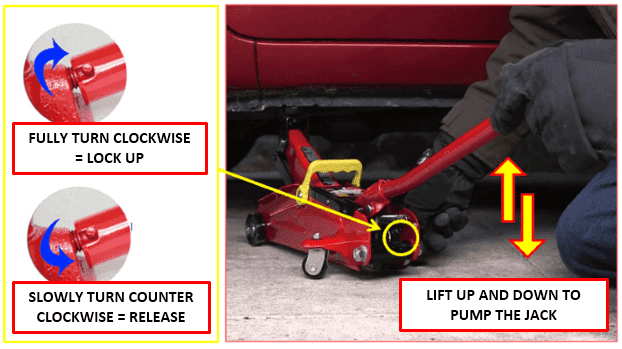How to use a car jack?
Car jacks are necessary to do car repair work at home in your garage or in emergencies. It serves to lift part of the car body, mainly when replacing a flat or leaking car tire. Even though it looks simple, using a car jack is not as easy as imagined. It takes some proper action according to the correct procedure to maintain our safety, both for the people who use it or the car itself.
Many things need to consider before you use the car jack. Among them are:
- The jack's type.
- The jack strength's size.
- The jack installation's correct position.
- The steps and sequences of using the car jack.
Check out the review using a car jack in the following article.
I. Types of jack and how to use them
There are many types of jack, but there are only three most commonly used as car jacks. Here are the types of jack and how to use them
1. Scissor Jack
The scissor jack is the most compact types of jack and takes up no space. It is mechanical types of jack that use a screw system to raise and lower its height. This jack is a standard tool that is common in every car. The way to use it is relatively easy, for example, rotating the lever clockwise to increase and vice versa to decrease.
The Scissor Jack is a type of jack that looks easy in theory but difficult to follow. The reason is, the levers provided are generally less comfortable to use. The thinness of the levers with curved ends can be problematic for those unfamiliar with using them. Even so, this scissor jack is the jack type that is mostly provided in light vehicles.
Here's how to use a scissor jack
- Place the scissor jacks in the proper and secure position for jacking up the vehicle.
- Take the lever bar
- Install it in the part that has a hole in the edge of the scissor jack
- Rotate the lever clockwise to lift and counterclockwise to lower it.
2. Bottle Jack
Like its bottle-like shape, the bottle jack is also the most common type of jack provided in vehicles after the scissor jack. The bottle jack's advantages are lighter and smaller dimensions and a much easier way to use than the scissor jack.
The bottle jack has been listed as a hydraulic jack category, so it is more comfortable to jack up the car than the scissor jack. The reason is, when using the bottle jack, we no longer rotate the thin lever but only lift and press the jack lever.
Understanding the hydraulic jack and the working principle of the hydraulic bottle jack
If the tube with a small surface is pressed down, then the tube's oil is also pressed. The fluid will transmit its pressure inside the pump. As a result, the jack's oil will generate a greater pressure inside the tube to lift the heavy load.
It is enough to pump the available lever on the bottle jack. The hydraulic system will automatically lift the load on it.
Here's how to use a bottle jack
- Place the bottle jack in the correct and safe position for jacking up the vehicle.
- Take the lever bar
- Turn the hydraulic lock clockwise (use the end of the jack handle)
- Move the jackshaft to the hydraulic pump lever, then pump by raising and lowering the jackshaft to lift the car.
- To lower the jack, slowly turn the hydraulic lock counterclockwise.
Also read:
- How to change oil filter spin-on type without draining oil
- Manual transmission fluid check
- How to jack up a car safely
3. Floor Jack
The next type of car jack that is commonly used for jacks is the floor jack. The floor jack also utilizes a hydraulic system, just like a bottle jack. Still, its lying position coupled with the wheels' addition makes this floor jack easier for us to jack.
Using a floor jack is similar to using a bottle jack. Still, it needs a little adjustment because of the different dimensions and positions.
Here's how to use the floor jack
- Place the floor jack in the correct and safe position for jacking up the vehicle.
- Take the lever bar
- Turn the hydraulic lock clockwise (you can use the end of the jack handle)
- Move the jackshaft to the hydraulic pump lever, then pump by raising and lowering the jackshaft to lift the car.
- To lower the jack, slowly turn the hydraulic lock counterclockwise.
II. Preparation before jacking up
For safety and security when using a car jack, here are the essential steps you need to know before using a car jack.
- Park the car on a flat, sturdy, and hard surface.
- Use the hand brake to keep the car from moving. If needed, use a block or stone to prop the tire on the other side to prevent the vehicle from moving.
- Select and use a jack whose strength is greater than the weight of the car. Also, make sure the jack is still working correctly, does not look like it is leaking or bent.
- Make sure the jack support on the car is correct. Generally, there is a mainframe between the axle rods near the suspension or the car's underbody.
- To be sure, please refer to the manual of each vehicle. This step is important to avoid slipping when you jack up the car.
- Avoid jacking above 15 centimeters to prevent the car from moving and skidding.
- Never put your body under the car when you only use the jack as the primary support because this action is hazardous. If you have to, use a jack stand to make it safer.




